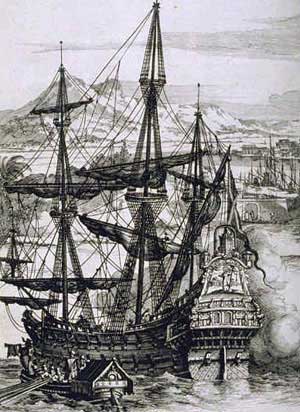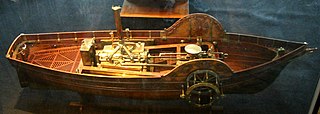
Robert Fulton was an American engineer and inventor who is widely credited with developing the world's first commercially successful steamboat, the North River Steamboat. In 1807, that steamboat traveled on the Hudson River with passengers from New York City to Albany and back again, a round trip of 300 nautical miles, in 62 hours. The success of his steamboat changed river traffic and trade on major American rivers.

John Ericsson was a Swedish-American engineer and inventor. He was active in England and the United States.

Narcís Monturiol i Estarriol was a Spanish inventor, artist and engineer born in Figueres, Spain. He was the inventor of the first air-independent and combustion-engine-driven submarine.

A steamboat is a boat that is propelled primarily by steam power, typically driving propellers or paddlewheels. The term steamboat is used to refer to small steam-powered vessels working on lakes, rivers, and in short-sea shipping. The development of the steamboat led to the larger steamship, which is a seaworthy and often ocean-going ship.

Galleons were large, multi-decked sailing ships developed in Spain and Portugal and first used as armed cargo carriers by Europeans from the 16th to 18th centuries during the Age of Sail and were the principal vessels drafted for use as warships until the Anglo-Dutch Wars of the mid-17th century. Galleons generally carried three or more masts with a lateen fore-and-aft rig on the rear masts, were carvel built with a prominent squared off raised stern, and used square-rigged sail plans on their fore-mast and main-masts.

A paddle steamer is a steamship or steamboat powered by a steam engine driving paddle wheels to propel the craft through the water. In antiquity, paddle wheelers followed the development of poles, oars and sails, whereby the first uses were wheelers driven by animals or humans.

Blasco Núñez Vela was the first Spanish viceroy of South America. Serving from May 15, 1544 to January 18, 1546, he was charged by Charles V with the enforcement of the controversial New Laws, which dealt with the failure of the encomienda system to protect the indigenous people of America from the rapacity of the conquistadors and their descendants.

The Age of Sail is a period in European history that lasted at the latest from the mid-16th to the mid-19th centuries, in which the dominance of sailing ships in global trade and warfare culminated, particularly marked by the introduction of naval artillery, and ultimately reached its highest extent at the advent of steam power. Enabled by the advances of the related Age of Navigation, it is identified as a distinctive element of the early modern period and the Age of Discovery.

An aeolipile, aeolipyle, or eolipile, from the Greek "Αἰόλου πύλη," lit. 'Aeolus gate', also known as a Hero'sengine, is a simple, bladeless radial steam turbine which spins when the central water container is heated. Torque is produced by steam jets exiting the turbine. The Greek-Egyptian mathematician and engineer Hero of Alexandria described the device in the 1st century AD, and many sources give him the credit for its invention. However, Vitruvius was the first to describe this appliance in his De architectura.

John Fitch was an American inventor, clockmaker, entrepreneur, and engineer. He was most famous for operating the first steamboat service in the United States. The first boat, 45 feet long, was tested on the Delaware River by Fitch and his design assistant Steven Pagano.

A galley is a type of ship optimised for propulsion by oars. Galleys were historically used for warfare, trade, and piracy mostly in the seas surrounding Europe. It developed in the Mediterranean world during antiquity and continued to exist in various forms until the early 19th century. It typically had a long, slender hull, shallow draft, and often a low freeboard. Most types of galleys also had sails that could be used in favourable winds, but they relied primarily on oars to move independently of winds and currents or in battle. The term "galley" originated from a Greek term for a small type of galley and came in use in English from about 1300. It has occasionally been used for unrelated vessels with similar military functions as galley but which were not Mediterranean in origin, such as medieval Scandinavian longships, 16th-century Acehnese ghalis and 18th-century North American gunboats.

A galley slave was a slave rowing in a galley, either a convicted criminal sentenced to work at the oar, or a kind of human chattel, sometimes a prisoner of war, assigned to the duty of rowing.

Pyroscaphe was an early experimental steamship built by Marquis de Jouffroy d'Abbans in 1783. The first demonstration took place on 15 July 1783 on the river Saône in France. After the first demonstration, it was said that the hull had opened up and the boiler was letting out steam, faults common in early steamboats. In this case, it seems to have been easily repaired as the boat was said to have made several trips up and down the river. A month later, on 19 August, the boat carried several passengers who signed a witness protocol for a successful journey.

Jerónimo de Ayanz y Beaumont was a Spanish soldier, painter, astronomer, musician and inventor. He pioneered the use and design of the steam engine, as well as mining ventilation systems, improved scientific instrumentation, developed windmills and new types of furnaces for metallurgical, industrial, military, and even domestic operations. He invented a diving bell, patented an immersion suit tested before the court of Felipe III in Pisuerga, on August 2, 1602, and designed a submarine.

SS Archimedes was a steamship built in Britain in 1839. She was the world's first steamship to be driven successfully by a screw propeller.
The Battle of Muros Bay took place on 25 July 1543, during the Italian War of 1542–1546, between the French fleet under Jean de Clamorgan, Lord of Soane and the Spanish fleet commanded by Álvaro de Bazán, 1st Marquis of Viso. This battle is considered to be the first large naval battle in the Atlantic Ocean.
The Battle of Barcelona was a naval engagement fought in the coastal region of Barcelona, Catalonia, Spain, between the navies of the Crowns of Aragon and Castile, during the War of the Two Peters. A number of months beforehand, a large Castilian fleet had been assembled at Seville by order of the King of Castile, Peter I. Consisting of 128 warships including royal vessels, ships from the King of Castile's vassals, and several others that had been sent by the Castilian-allied monarchs of Portugal and Granada, this large fleet had been entrusted to the Genoese admiral, Egidio Boccanegra, who was seconded by two of his relatives, Ambrogio and Bartolome.

Lanong were large outrigger warships used by the Iranun and the Banguingui people of the Philippines. They could reach up to 30 m (98 ft) in length and had two biped shear masts which doubled as boarding ladders. They also had one to three banks of oars rowed by galley slaves. They were specialized for naval battles. They were prominently used for piracy and slave raids from the mid-18th century to the early 19th century in most of Southeast Asia. The name lanong is derived from Lanun, an exonym of the Iranun people.

Garay were traditional native warships of the Banguingui people in the Philippines and were used by the Bruneian Navy. In the 18th and 19th centuries, they were commonly used for piracy by the Banguingui and Iranun people against unarmed trading ships and raids on coastal settlements in the regions surrounding the Sulu Sea.

Guilalo, were large Tagalog outrigger ships from the Philippines. They were common vessels in Manila Bay in the 18th and 19th centuries. They were easily identifiable by their two large settee sails made with woven fiber. They were steered by a central rudder and can be rowed with round-bladed oars.
















